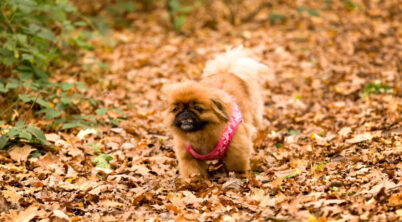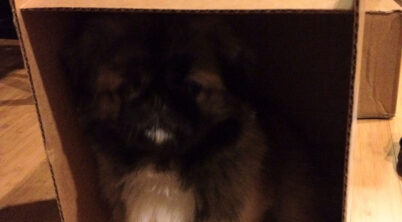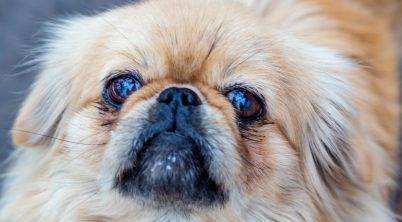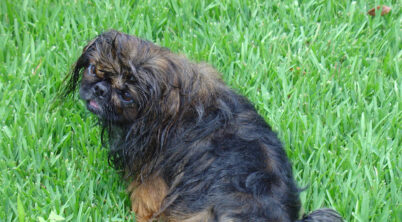The Pekingese is a breed with a storied past, hailing from the imperial courts of ancient China. This small dog, with its distinctive lion-like mane and snub nose, has a confident and somewhat regal bearing, reflective of its heritage as a favored pet of Chinese royalty. In their demeanor, Pekingese display an independent temperament, often being both affectionate with their owners and reserved around strangers. It is this spirited personality that makes playtime with a Pekingese an engaging and delightful experience for both the dog and the owner alike.
Despite their size, Pekingese have a bold and courageous spirit. Their playful activities not only serve as a form of exercise but also offer mental stimulation and an opportunity for these canines to express their innate behavioral patterns. These dogs may not require extensive physical exercise, but their need for interaction and engagement should not be underestimated. With their long, flowing coats, they can appear to be frolicking balls of fluff when at play.
When it comes to Pekingese at play, owners should be mindful of their physical limitations. Due to their brachycephalic (flat-faced) features, they are prone to breathing difficulties, especially in hot weather, making it necessary for play sessions to be managed carefully to prevent overheating. Moreover, their short legs and stout bodies mean that physical activities should be tailored to their compact size to avoid injuries. With this in mind, Pekingese owners can create a safe and enjoyable environment that caters to the breed’s unique characteristics, ensuring that playtime is both entertaining and beneficial for their furry companions.
Table of Contents
Pekingese Playing
Pekingese dogs possess a playful nature that shines through their charming antics. When they are ready to engage in play, they often assume a distinctive stance known as the play bow. This involves them lowering their front end while keeping their hindquarters raised, signaling their desire for interaction and fun.
During playtime, these dogs enjoy a variety of activities. Here’s a simple guide to their play preferences:
- Short Walks: Pekingese require only moderate exercise and are content with brief but enjoyable strolls.
- Indoor Games: Suitable for apartment living, they enjoy playful interactions indoors which cater to their exercise needs without overexertion.
- Interactive Toys: Engage their minds with puzzle toys that stimulate them both mentally and physically.
It’s important to understand that the Pekingese may face certain challenges during vigorous activities. Their physical structure, with a flat face and short nose, makes them prone to breathing difficulties, especially during warmer weather. Here are some recommendations for a safe play environment:
- Cool Temperatures: Play with them in cooler environments to prevent heatstroke.
- Calm Play Style: Tailor activities to be gentler to accommodate their breathing.
Finally, Pekingese treasure attention and affection. Regular play strengthens the bond between pet and owner, reinforcing companionship. Treats used wisely during play can enhance teaching moments and reward good behavior. With the right balance of play, rest, and interaction, the Pekingese remains an amiable and lively companion.
Fun and Play
Engaging in play is essential for Pekingese dogs, as it stimulates their mind, provides physical exercise, and strengthens the bond between them and their owners. They are intelligent and have a moderate energy level that can be channeled through interactive games and suitable toys designed for their entertainment and agility.
Recommended Games
- Tag: The game involves family members calling the Pekingese’s name and encouraging it to run towards them. Another family member then repeats the process, promoting both obedience and agility.
- Fetch: Although not all Pekingese may naturally retrieve, they can be encouraged to engage in a gentle game of fetch with small, lightweight toys appropriate for their size.
By incorporating these games into their routine, owners can cater to their Pekingese’s playful nature and energy needs.
Toys and Entertainment
When selecting toys for a Pekingese, one should consider the following:
- Durability: Toys must be sturdy enough to withstand their strong-willed nature but soft enough for their small mouths.
- Appropriate Size: The toys should be small and lightweight to match the Pekingese’s petite stature and prevent any strain during play.
The right toys and engaging games can greatly contribute to a Pekingese’s well-being by enhancing their mental stimulation and physical vitality.
Temperament and Behavior
The Pekingese breed displays a complex temperament that intertwines loyalty and affection with a notable streak of independence. Peke owners find their dogs to be both loving companions and, at times, quite stubborn.
Personality Traits
The Pekingese is confident and self-assured; they carry themselves with dignity and a certain regal grace. Often seen as stubborn, this trait can be attributed to their strong-willed nature. Despite their small size, they have a bold and courageous spirit. Their personality is multi-faceted: they can be affectionate and loving towards their families, relishing the time spent in play and interaction, yet they may also display an independent streak, happy to entertain themselves.
Interaction with Family
Pekes form deep loyal bonds with their family members and are especially good with those they are familiar with, often protective of them. This protectiveness can manifest in a temperament that is wary of strangers, though never aggressive without cause. They’re known for being affectionate with family, but their playful interactions should be monitored with children, as they don’t tolerate rough treatment well. When playing, they often engage with a gentle and loving demeanor but may assert their independence if the play becomes too boisterous.
Health and Wellness
Pekingese dogs are adored for their affectionate nature and majestic bearing. However, their distinct physical features contribute to specific health concerns that owners should monitor for a thriving pet.
Common Health Issues
The Pekingese breed, being brachycephalic, is susceptible to respiratory issues due to its short nose and flat face. This can lead to breathing difficulties, especially during exercise or in hot weather. Patellar luxation is another condition often seen in Pekingese where the knee cap slips out of place, which can impact mobility. Eye problems also prevail; entropion, where the eyelid rolls inward, can cause irritation and should be addressed by a veterinarian.
- Brachycephalic Airway Syndrome: May present respiratory challenges.
- Patellar Luxation: Affecting the knee joint, potentially causing lameness or pain.
- Eye Conditions: Such as entropion, leading to discomfort and visual impairment.
Veterinary Care
To maintain their health, regular check-ups with a veterinarian are crucial. During these visits, a Pekingese can receive necessary vaccinations and health screenings to catch and manage potential issues early. Additionally, dental hygiene is paramount due to their small mouths, which can be prone to periodontal disease.
- Routine Exams: Includes assessment of respiratory function and knee stability.
- Vaccinations: Essential for preventing infectious diseases.
- Dental Care: To prevent periodontal diseases, regular dental check-ups are vital.
Owners must remain vigilant about their Pekingese’s health and consult a veterinarian to ensure a quality life typically ranging from 12 to 14 years.
Training and Socialization
The Pekingese breed requires a thoughtful approach to training and socialization that addresses their intelligent yet independent nature. Achieving a well-behaved Pekingese entails employing effective training techniques from an early age and ensuring thorough socialization to foster a confident and loyal companion.
Training Techniques
Pekingese dogs benefit from positive reinforcement—rewards such as treats or praise can significantly motivate them during training sessions. Consistency is crucial; repetition helps solidify obedience commands like sit, stay, come, and down. Trainers should keep sessions short to maintain the dog’s attention and incorporate play to make learning enjoyable. High-energy games can double as exercise and training opportunities.
- Reward-Based Training: Utilize treats or praise to encourage desired behavior.
- Consistency: Repeat commands and maintain a regular training schedule.
- Short Sessions: Keep training brief to suit the Pekingese’s attention span.
- Incorporate Play: Use games that cater to their intelligence and energy levels.
Importance of Early Socialization
For Pekingese puppies, early socialization is paramount to develop their social skills and prevent future behavioral issues. Introducing them to different people, animals, and environments early helps them become well-adjusted adults. Interaction in various settings can prevent a Pekingese from becoming overly territorial or shy. Regular and gentle socialization fosters a dog’s ability to engage confidently with the world around them.
- Diverse Interactions: Introduce puppies to varying settings, animals, and people.
- Ongoing Process: Socialization should continue beyond puppyhood.
- Preventive Measure: Early socialization can curb potential negative behaviors.
- Builds Confidence: Positive encounters help Pekingese dogs become adaptable and friendly.








